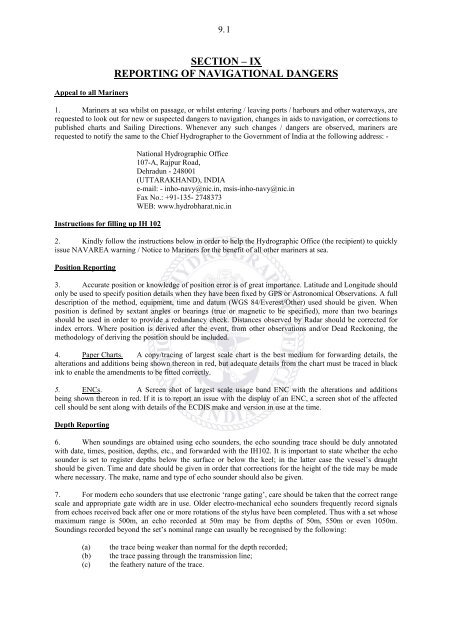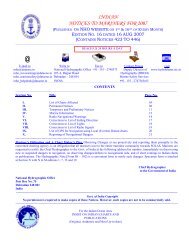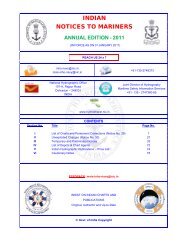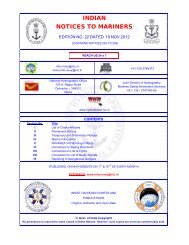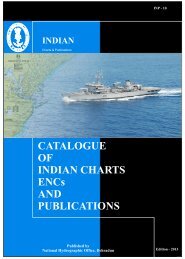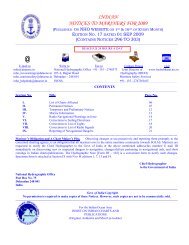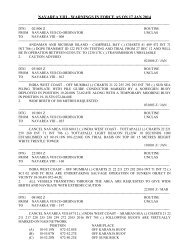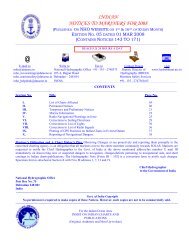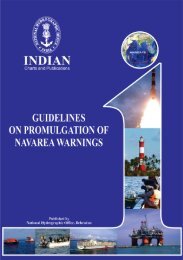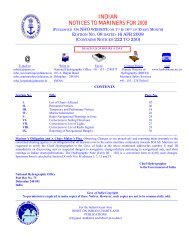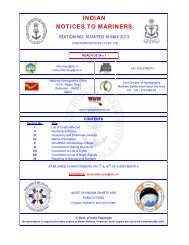INDIAN NOTICES TO MARINERS - National Hydrographic Office
INDIAN NOTICES TO MARINERS - National Hydrographic Office
INDIAN NOTICES TO MARINERS - National Hydrographic Office
Create successful ePaper yourself
Turn your PDF publications into a flip-book with our unique Google optimized e-Paper software.
9. 1<br />
Appeal to all Mariners<br />
SECTION – IX<br />
REPORTING OF NAVIGATIONAL DANGERS<br />
1. Mariners at sea whilst on passage, or whilst entering / leaving ports / harbours and other waterways, are<br />
requested to look out for new or suspected dangers to navigation, changes in aids to navigation, or corrections to<br />
published charts and Sailing Directions. Whenever any such changes / dangers are observed, mariners are<br />
requested to notify the same to the Chief Hydrographer to the Government of India at the following address: -<br />
Instructions for filling up IH 102<br />
<strong>National</strong> <strong>Hydrographic</strong> <strong>Office</strong><br />
107-A, Rajpur Road,<br />
Dehradun - 248001<br />
(UTTARAKHAND), INDIA<br />
e-mail: - inho-navy@nic.in, msis-inho-navy@nic.in<br />
Fax No.: +91-135- 2748373<br />
WEB: www.hydrobharat.nic.in<br />
2. Kindly follow the instructions below in order to help the <strong>Hydrographic</strong> <strong>Office</strong> (the recipient) to quickly<br />
issue NAVAREA warning / Notice to Mariners for the benefit of all other mariners at sea.<br />
Position Reporting<br />
3. Accurate position or knowledge of position error is of great importance. Latitude and Longitude should<br />
only be used to specify position details when they have been fixed by GPS or Astronomical Observations. A full<br />
description of the method, equipment, time and datum (WGS 84/Everest/Other) used should be given. When<br />
position is defined by sextant angles or bearings (true or magnetic to be specified), more than two bearings<br />
should be used in order to provide a redundancy check. Distances observed by Radar should be corrected for<br />
index errors. Where position is derived after the event, from other observations and/or Dead Reckoning, the<br />
methodology of deriving the position should be included.<br />
4. Paper Charts. A copy/tracing of largest scale chart is the best medium for forwarding details, the<br />
alterations and additions being shown thereon in red, but adequate details from the chart must be traced in black<br />
ink to enable the amendments to be fitted correctly.<br />
5. ENCs. A Screen shot of largest scale usage band ENC with the alterations and additions<br />
being shown thereon in red. If it is to report an issue with the display of an ENC, a screen shot of the affected<br />
cell should be sent along with details of the ECDIS make and version in use at the time.<br />
Depth Reporting<br />
6. When soundings are obtained using echo sounders, the echo sounding trace should be duly annotated<br />
with date, times, position, depths, etc., and forwarded with the IH102. It is important to state whether the echo<br />
sounder is set to register depths below the surface or below the keel; in the latter case the vessel’s draught<br />
should be given. Time and date should be given in order that corrections for the height of the tide may be made<br />
where necessary. The make, name and type of echo sounder should also be given.<br />
7. For modern echo sounders that use electronic ‘range gating’, care should be taken that the correct range<br />
scale and appropriate gate width are in use. Older electro-mechanical echo sounders frequently record signals<br />
from echoes received back after one or more rotations of the stylus have been completed. Thus with a set whose<br />
maximum range is 500m, an echo recorded at 50m may be from depths of 50m, 550m or even 1050m.<br />
Soundings recorded beyond the set’s nominal range can usually be recognised by the following:<br />
(a)<br />
(b)<br />
(c)<br />
the trace being weaker than normal for the depth recorded;<br />
the trace passing through the transmission line;<br />
the feathery nature of the trace.


